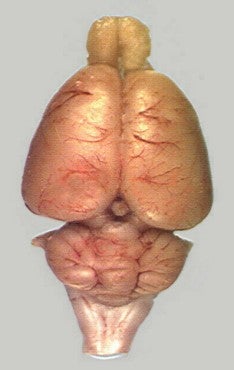
The figure shows the whole brain of the rat. Labeled sections of the mouse brain can be accessed from the Allen Brain Atlas. See also the book The Rat Brain in Stereotaxic Coordinates by C. Watson and G.T. Paxinos.
About Laboratory Rats*
The Laboratory Rat was developed from the Norwegian Rat (Rattus norvegicus) by an American Physiologist, Henry Donaldson, who started a breeding colony in 1906 at the Wistar Institute in Philadelphia. Three principal strains are now commonly used for scientific study:
Wistar Albino: Developed at the Wistar Institute. Wide head, long ears, tail length always less that the body length.
Sprague-Dawley Albino: Developed at Sprague-Dawley farms, Wisconsin. Longer and narrower head than Wistar, longer tail, which may equal or be longer than the body length.
Long-Evans or Lister Hooded: Developed by Drs. Long and Evans in 1915 by cross-breeding Wistar albino females with a wild gray male. A smaller variety, white with black (or occasionally brown) hood over head and back of neck, with a line down the back.
Life Cycle
| Age (days) | Weight (g) | Development |
| Birth | 5 | hairless, toothless, closed eyes and ears |
| 4 | 10 | hair begins to appear |
| 10 | . | covered with hair |
| 13 | . | eyes and ears open |
| 21 | 30-50 | weaning |
| 40-50 | 150-200 | sexual maturity |
| 72 | 200 - 400 | young adult |
| 250-300 | 270 - 800 | full grown; males larger than females |
| 1000-1300 | . | end of normal life span |
*Please note that all procedures involving laboratory rats follow NIH Guidelines for the humane care and use of laboratory animals.